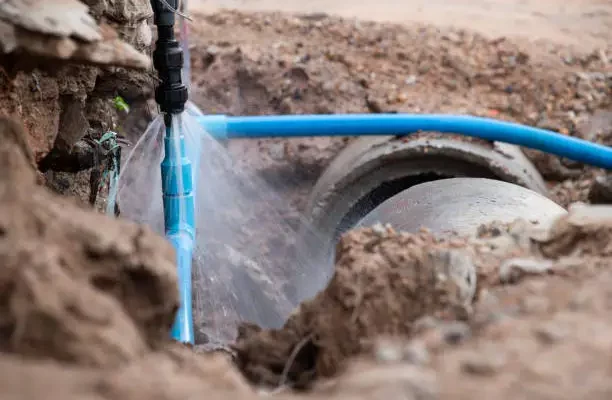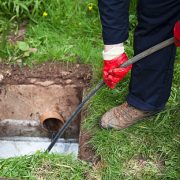When contemplating a water line replacement, several concerns may cross your mind. Firstly, you may worry about the potential destruction of your lawn. Additionally, the financial burden associated with replacing the main water line may loom large in your thoughts.
Nevertheless, despite the costs involved, you cannot simply go without a functioning water line. This is a necessary sacrifice that you, like many other homeowners, will eventually have to undertake. But what if we informed you that there’s an alternative?
Recent advancements in pipe clearing and replacement technologies have all but eliminated the necessity for extensive excavation, sparing homeowners from the accompanying inconveniences. Thanks to trenchless technologies, replacing a water main line can be a swift solution rather than a strenuous ordeal.
Water Line Replacement Highlights:
1. Efficiency in Modern Line Replacement
When discussing broken water lines or urgent plumbing issues that can arise in various scenarios with homeowners, it often surprises them to learn that renovations can be completed within a single day. How is this remarkable efficiency achieved?
Innovative trenchless technologies empower plumbing experts to carry out complete water line replacements in a matter of hours, eliminating the need for extensive manual labor and digging. By employing advanced subterranean techniques, these professionals can fully replace your water line pipes in a fraction of the time required by other methods.
2. Preservation of Your Lawn with Trenchless Solutions
Utilizing epoxy Perma-liner solutions, trenchless specialists can repair or replace underground segments of damaged pipes without excavation. They create small, minimally invasive access points and, through the application of air pressure, coat these solutions along the interior walls of the existing pipes.
Using an elongated air bladder, specialists then cure the pipe to the inner walls, resulting in a completely restored pipe in just a matter of hours. This entirely eliminates the need for costly pipe digging, commonly known as ‘trenching,’ all while ensuring high-quality water line replacements.
3. Cost Savings through Trenchless Technologies
The absence of excavation, a seamless installation process, and reduced overhead expenses collectively translate into a significant advantage for homeowners: substantial cost savings. A trenchless water line replacement not only makes practical sense but also proves financially advantageous.
4. Exceptional Longevity of Trenchless Water Lines
As we briefly mentioned earlier in this article, it’s crucial for homeowners to understand the impressive lifespan of trenchless water line replacements. While you might mistakenly believe that materials like Perma-liner or PVC replacements are less reliable than others, this is a misconception that needs clarification.
Once installed, homeowners can confidently anticipate their new pipes to endure for at least 50 years, often exceeding this benchmark. These newly installed pipes not only boast ease of installation but also provide homeowners with the peace of mind they seek in their plumbing systems.
5. Versatile Solutions for All Types of Damage
Prior to initiating replacement installation, trenchless plumbing specialists employ video inspection equipment to assess the nature and extent of damage to your water line. It’s important to note that this evaluation is not merely a determination of whether the pipe can be fixed; rather, it serves evaluative purposes.
In reality, trenchless solutions can effectively address damage from various sources and types. Whether your line suffers from corrosion, root intrusion, shifting soil, or fractures, trenchless replacements are equipped to meet your specific line repair requirements.
6. Preventative Value of Trenchless Technologies
Often overlooked by many homeowners dealing with water line damage is the preventive potential of trenchless repair methods. Similar to addressing any other form of home damage and repair, timely action is paramount.
Swiftly responding to water line damage and opting for innovative trenchless repairs can spare you from more costly and extensive renovations in the future. By taking prompt action and treating water line issues seriously, homeowners can access repairs at more suitable and affordable times.
7. Professional Assessment for Replacement Needs
Employing advanced video inspection technology, plumbing specialists can precisely gauge the extent of damage to your home’s water line and assist you in determining the appropriate repair solutions. Some situations necessitate complete pipe bursting renovations, while others may require relining or sectional repair.
Through proactive inspection, trenchless technology experts guide you toward the right solutions, preventing damages from worsening and ultimately saving you on repair costs.
8. Local Expertise for Optimal Solutions
One often overlooked aspect when selecting a trenchless specialist is the significance of hiring locally, as opposed to opting for national or regional companies. While larger entities may offer adequate solutions, they can’t match the effectiveness of businesses rooted in your local community.
Local plumbing experts possess an in-depth understanding of the local geographical environment, prevailing weather conditions, and common plumbing systems unique to your area. Consequently, they can deliver tailored solutions that perfectly align with your needs when it comes to such a critical element as a functioning water line.
Frequently Asked Questions About Water Line Replacement
1. What exactly is a water line?
Your home’s water main line is the conduit responsible for distributing water throughout your residence. Water supply lines branch off from the main line to deliver water to different areas within your house.
2. How often should water lines be replaced?
Water lines are engineered to last for a minimum of 50 years, with the specific lifespan contingent on the type of pipe material employed. Copper pipes, for instance, can endure for 70-80 years, while brass or galvanized steel pipes may last 80-100 years.
Nevertheless, it is recommended to schedule a pipe inspection every 1-3 years. These inspections serve to verify the proper functioning of your pipes and to identify any cracks or signs of damage. Instances of tree roots infiltrating pipes and causing cracks or breakages are not uncommon. Regular inspections every 1-3 years can help avert more expensive issues in the future.




















